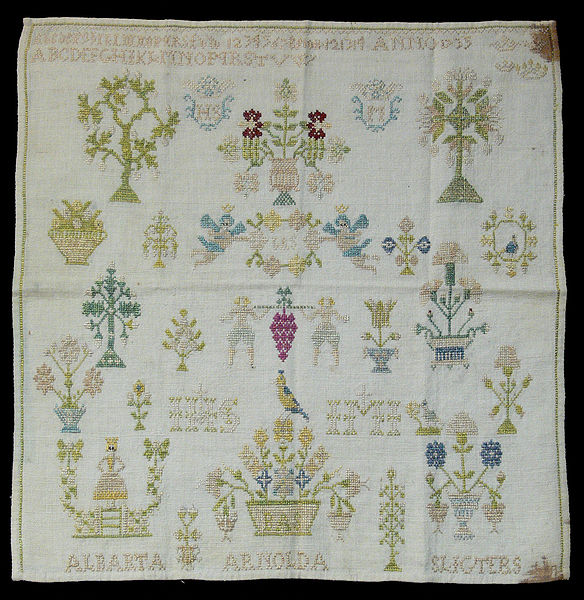Cross-stitch is a form of sewing and a popular form of counted-thread embroidery in which X-shaped stitches in a tiled, raster-like pattern are used to form a picture. The stitcher counts the threads on a piece of evenweave fabric in each direction so that the stitches are of uniform size and appearance. This form of cross-stitch is also called counted cross-stitch in order to distinguish it from other forms of cross-stitch. Sometimes cross-stitch is done on designs printed on the fabric ; the stitcher simply stitches over the printed pattern. Cross-stitch is often executed on easily countable fabric called aida cloth, whose weave creates a plainly visible grid of squares with holes for the needle at each corner.
Cross-stitch sampler, Germany
Cross stitching using a hoop and showing use of enamel needle minder
Cross-stitch sampler by Sarah Littleton, 1868
Detail of floral border pattern in cotton. Tea cloth (small tablecloth), Hungary, mid-twentieth century.
A needlework sampler is a piece of embroidery or cross-stitching produced as a 'specimen of achievement', demonstration or a test of skill in needlework. It often includes the alphabet, figures, motifs, decorative borders and sometimes the name of the person who embroidered it and the date. The word sampler is derived from the Latin exemplum, which means 'example'.
An American sampler: "Margaret Barnholt her sampler done in the twelth [sic] year of her age 1831".
English band sampler featuring 'boxers', c. 1650
Cross-stitch alphabet sampler worked by Elizabeth Laidman, 1760
'Biblical' sampler by Elizabeth Ross dated 1786





![An American sampler: "Margaret Barnholt her sampler done in the twelth [sic] year of her age 1831".](https://upload.wikimedia.org/wikipedia/commons/thumb/7/7b/Sampler_%28USA%29%2C_1831_%28CH_18564023%29.jpg/600px-Sampler_%28USA%29%2C_1831_%28CH_18564023%29.jpg)


